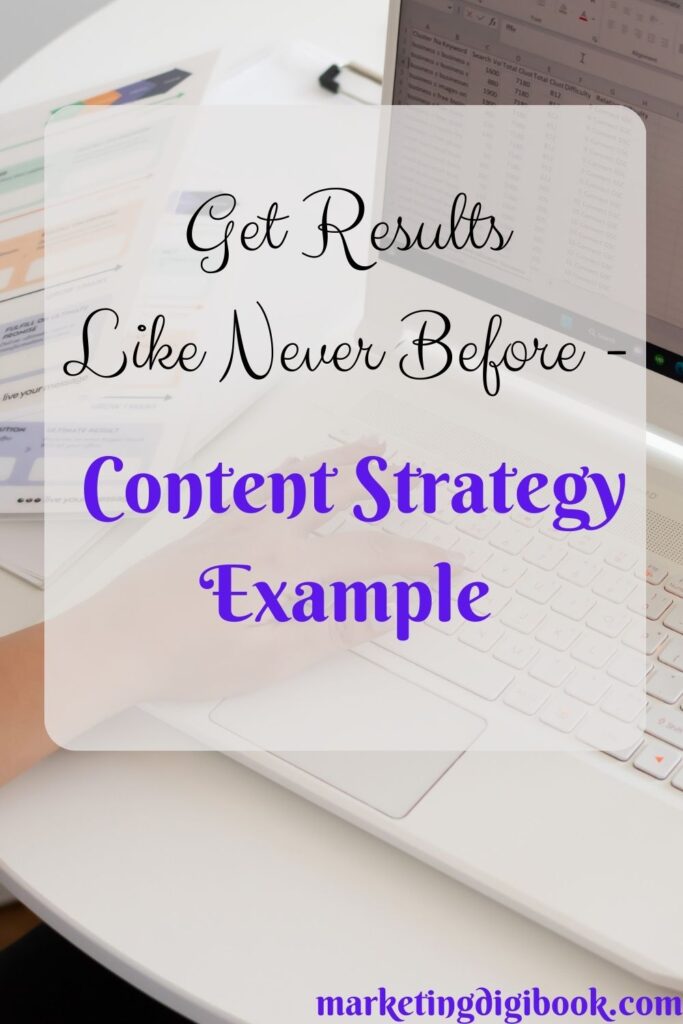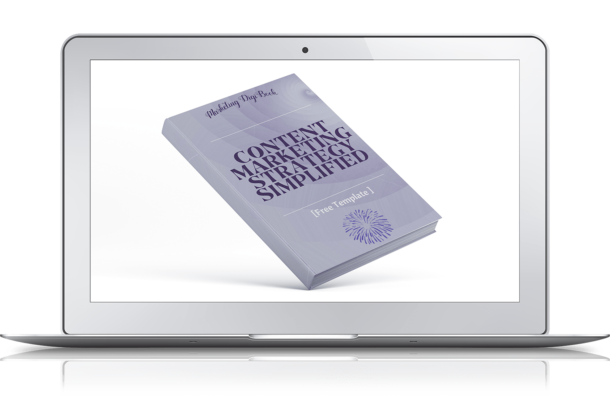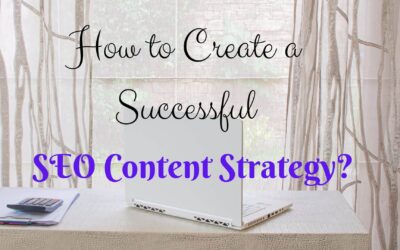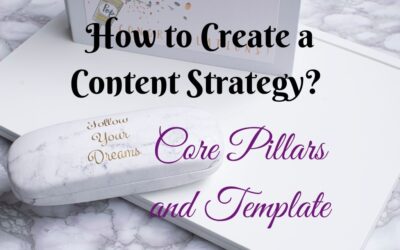When trying to put in place a content strategy, even if you have a pretty good idea of what you need to do, an already completed content strategy example would be very helpful.
To give you a hand, I have created such an example using my simplified content strategy template.
By the end of this article, you will be able to create the content strategy for your business with little or no help.
The foundation for the content strategy exemplified will be my content strategy framework which includes all the details for a results-driven strategy.
Click here to download the strategy template or complete the form below.
Now that you already have the skeleton – the strategy template, let’s put some “clothes” on.
The content strategy is practically a framework that comprises processes, topics, and standards to support your business in planning, executing, and publishing your content.
It’s a blueprint that organizes and manages the teams involved in content marketing activities: content managers, SEO specialists, writers, designers, editors, video producers, analysts, project managers, etc.
Content strategy’s main purpose is to have all the stakeholders on the same page and working toward the same goal.
Your strategy has to be adaptable and your team flexible and agile. In our laser speed era, changes appear in a cascade and it happens often that the situation foretold this month will have very little connection with reality within a couple of months.
No need to reinstate why you need a strategy content. It’s vital if you want to reach your goals in an efficient manner.
When looking to arrive from place A to place B, you use a GPS app. The same situation applies to your business. To reach your goals a clear path is needed, and that’s the strategy.
If still in doubt, check on statistics, organized marketers have higher chances to reach success – by far – like 674% more chances.
Let’s build an example of content strategy for the following business – you are a content marketing agency and you want to create a content strategy for your business. You provide your clients with content strategy services, SEO services, and social media services.
Let’s Make Your SEO & Content Work Better for Your Business
Content Strategy Example: Create Your Mission Statement
The template starts with the basics: the mission of your company, tailored for the content needs.
The mission is the engagement your company assumes in front of its audience and clients.
From this statement, you can establish the starting point of your content strategy.
The statement might look like this:
[Company] has the principal mission to deliver for our clients [service/product 1] and [service/product 2] via [task one] and [task two].
Example:
Caribbean Experiences exists to provide its customers, passionate travelers, with stellar accommodations and Caribbean-flavored experiences through a network of great beach properties and organized tours.
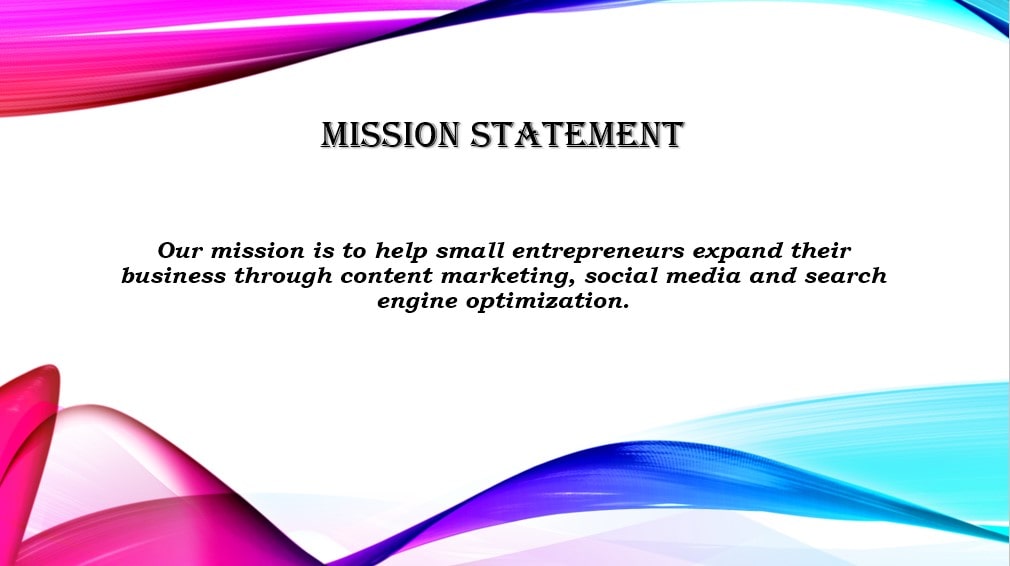
Define the Components of Your Content Marketing Team and the Associated Tasks
The starting point in the content strategy process is to create a team that will work to define, implement and accomplish it. Who will work and what exactly will execute?
In general, each team accomplishes more or less similar roles, and these are:
- Content Manager/Strategist: brainstorms, plans, and decides the content to be created.
- Writers: using their writing abilities they create the content.
- Proofreaders/Editors: verify and copyedit content to ensure accuracy.
- Designers: design visuals (photos, graphics, infographics) according to standards required by the brand.
- Distribution Manager: promotes content on established channels.
- SEO Specialists: optimize content to rank higher in SERPs and attract more readers and leads.
- Content Analysts: analyze content performance and identify which content brings expected results and which does not.
Take into consideration that a person may have multiple roles, or a team member may perform tasks that do not match exactly with their title.
I don’t want to see you running quicker than Usain Bolt from this task, so see below the task completed.
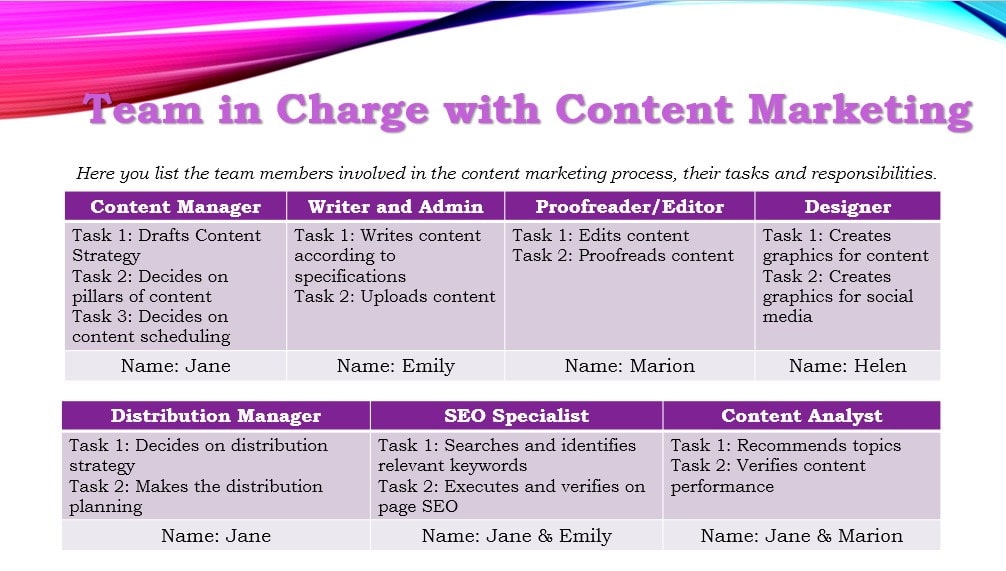
Content Strategy Example: Content Marketing Toolbox
Content marketing is a complex process that needs a handful of tools to keep things organized.
What kind of tools do you need?
Application for Analytics
Using an analytics platform is a must, as you need to measure your content performance and promotion efforts and adjust accordingly.
Some popular options are:
- Google Analytics
- Matomo
- Open Web Analytics.
Editorial Calendar for Content Marketing
Having a reliable editorial calendar to help you plan, schedule for publishing in advance, and publish according to deadlines can make a difference.
There are multiple options to choose from, some of the most popular:
- CoSchedule
- Google Calendar
- Trello
- Basecamp
Social Media Management Solutions
Social media is a significant part of any marketing strategy and, as such, of a content strategy. And is also a very time-consuming activity, that’s why using tools that help you automate part of the process is very convenient.
There are many options for social media schedulers, so you have to choose one that best suits your needs. Prominent solutions are:
- SproutSocial
- Hootsuite
- Buffer
- Tailwind
SEO Apps
To help your content rank in search engines and be found, you also need some SEO tools to identify the most reliable keywords, audit your site, measure performance, research competition, etc.
Some of the best tools for SEO today are:
- Ahrefs
- Semrush
- Moz
Marketing Project Management Tools
Managing a content marketing team can be an overwhelming task. And project management tools help to put the order in “chaos”.
Relevant options are:
• Asana • Trello • Wrike • Slack
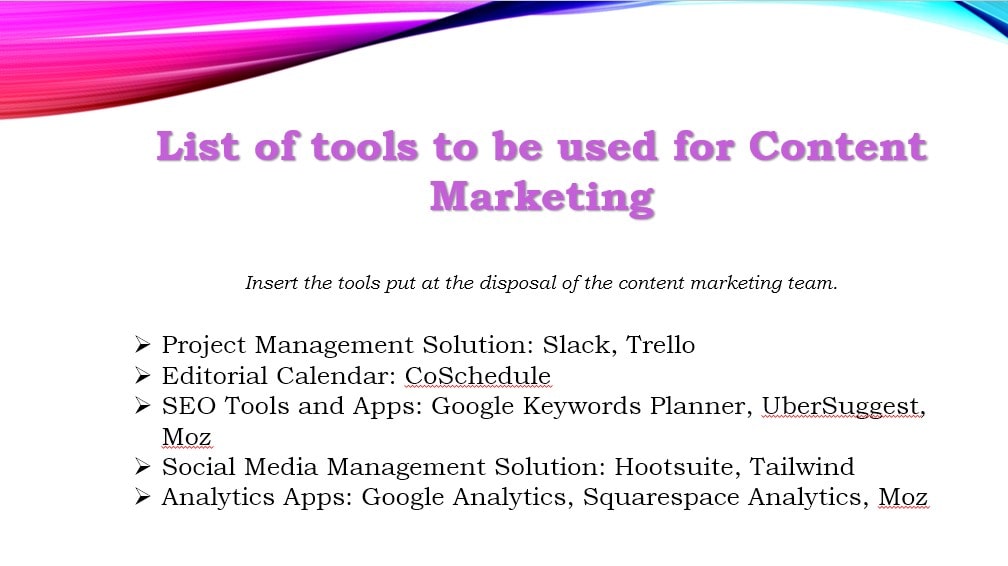
Content Strategy Example: Content Audit
If your business is not new and has some content marketing activities done, before creating a content strategy for the following period, a content audit is needed.
• Make an inventory of the existing content. What content is already published, where, and what is its format? Create a list with data like the permalink of the article, author, date of publication, number of words, last update, main keyword, page, views, impressions, authority, place in SERPs, etc.
• Audit your content from a qualitative point of view. Answer questions like What articles are the most performant as traffic generators? What is their bounce rate? How about dwell time? Is the published content converting as per the established targets? Investigate and find the answers to such questions.
• Identify content gaps and topics not yet covered.
• Competitors analysis. Check on what content marketing activities develops your competition and what results it gets.
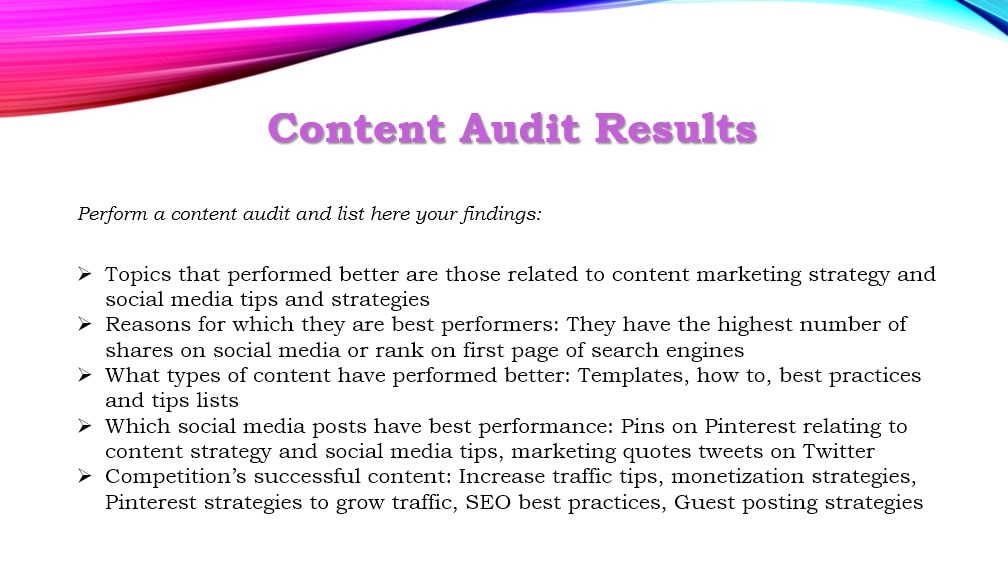
Content Marketing Goals
The guiding line of your content strategy is the goals that your business needs to achieve via its marketing activities. Such business goals are established by the business owners, shareholders, or top management of the organization.
Examples of such goals are:
• Create/increase brand awareness.
• Raise the traffic of your website by x%. Either via SEO – organic traffic and results will take a bit longer to appear. Or via ads – paid traffic, results appear quicker but need a higher budget.
• Boost conversions by x% for your offers.
• Establish your business as a leader/expert in your niche.
Based on these general business goals, the goals for content marketing will be established.
Be aware to define S.M.A.R.T. goals:
- Specific: Indicate exactly and clearly what you need to accomplish.
- Measurable: an exact level, number, or milestone to define them
- Attainable: realistic and approachable
- Relevant: goals to be meaningful for your business
- Timely: exact deadline in time
Example of SMART goals:
The [company]’s team responsible for X activity will attain [metric] by [interval].
Eagle Advertising’s team responsible for content marketing will attain 6.000 monthly visitors to our website by April 30, 2023
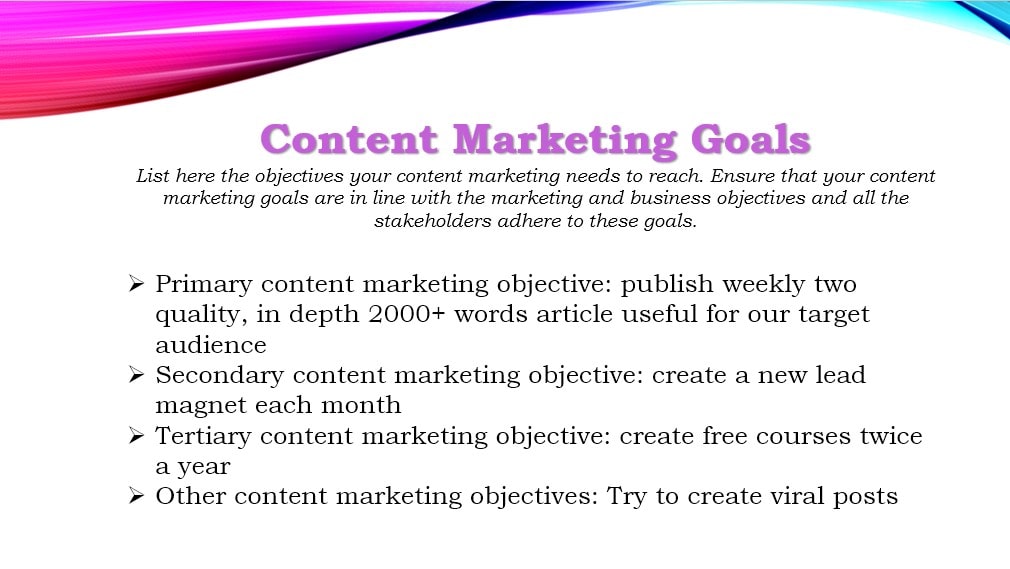
Audience Research and Buyer Persona Creation
Who do you want to reach? Who’s your ideal customer?
Your content marketing efficiency is expressed by the audience, leads, and sales it attracts. If your content generates thousands of views, but only a very small fraction are potential leads who buy your product/services, your content’s efficiency needs heavy improvements.
Identifying your target audience will enable your content strategists to nail what topics, subtopics, and keywords should be covered by your strategy. What your audience wants to know and what are her challenges/problems?
Correctly identify the characteristics of your target audience:
- Demographics: gender, age, income, job title, geolocation, etc.
- Psychographics: interests, hobbies, beliefs, habits, etc.
- Problems: What is the issue that would determine them to look for a product/service like yours?
- Pain points: What issues are resolved by your product/services? What is the cause of your audience’s problems?
- Where are they scouring for data and information?
- What’s their favorite type of content?
- In what ways can your content be beneficial to them?
You might have multiple buyer persona profiles, therefore, modify the template as per your needs.
To obtain these details regarding your buyer persona, you can:
• Refer to your Audience section in Google Analytics if you have an existing audience.
• Conduct a survey using tools such as Survey Monkey or Google Forms to gather relevant data.
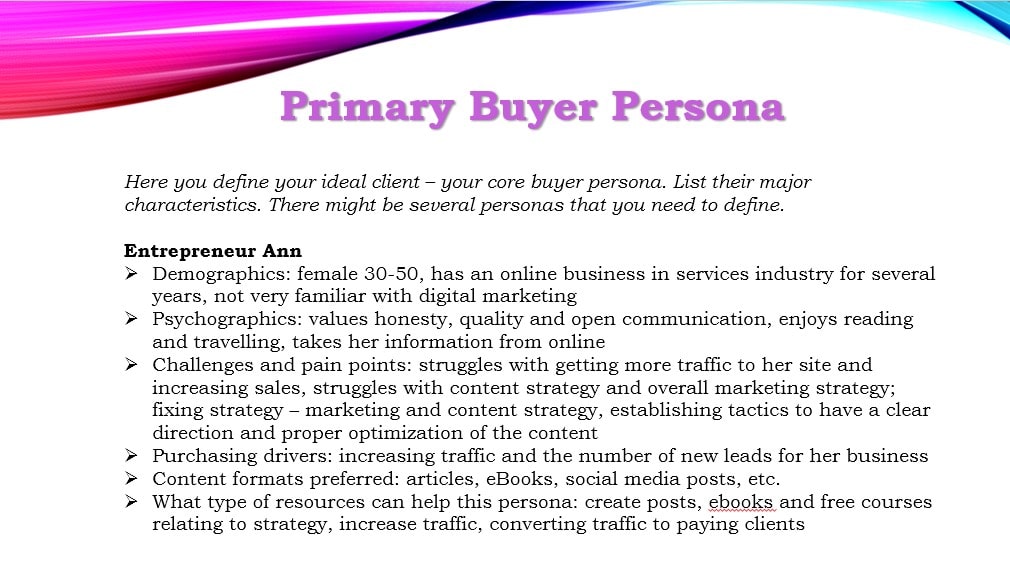
Content Strategy Example: Identify the Content Pillars and the Associated Topics
This is the foundation of your content creation efforts. The content that you produce must pertain to the products or services you offer and address the inquiries, requirements, challenges, and difficulties of your audience in relation to them.
For our content marketing agency example, for its SEO services, the content pillars may be:
– SEO audit
– Off-Page SEO
– On-Page SEO
– Increasing traffic
– Technical audit
– Ranking Algorithms
Each pillar will have topics and types of content assigned.
For example, a pillar called “Off-Page SEO” may include topics like:
– Outreach strategies to get backlinks
– How to guest post with maximum success
– Skyscraper strategy
– How to create infographics
What Type of Content to Create?
There are numerous forms of content that you can utilize to captivate your audience.
Content marketing is a vast field that extends beyond conventional blog posts, despite being its cornerstone.
What are the most common types of content?
- Articles/Blog Posts
- Case Studies
- Videos
- Infographics
- eBooks
- Reports
- Webinars
- Guides
- Social Media Content
- White Papers
- Newsletters
Identify your audience’s preferences and choose the right types of content to create accordingly.
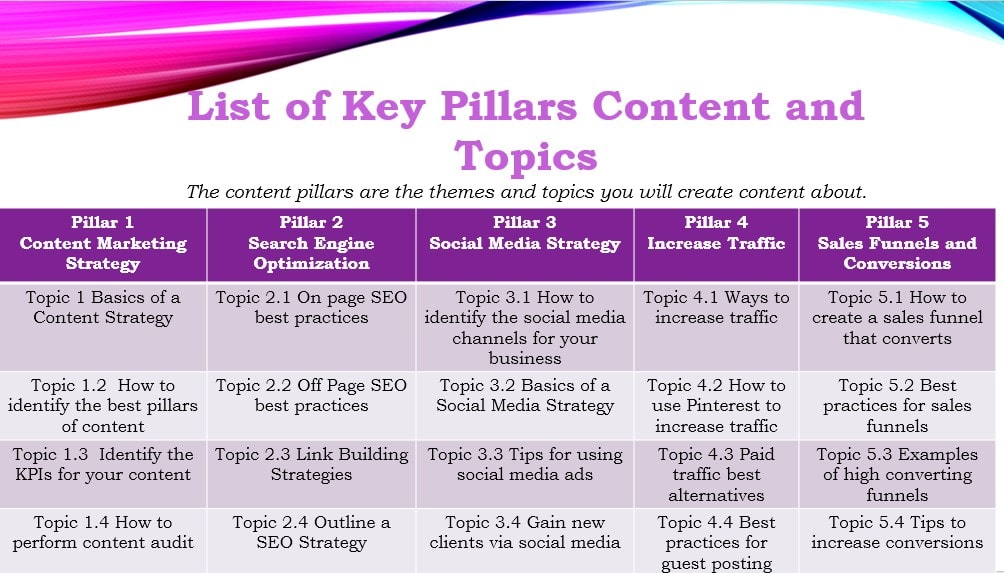
Choose Which Will Be the Voice and Tone of Your Brand
Defining the voice and tone that will be used throughout all your content marketing is important for consistency and coherence.
The voice of your brand is an expression of the personality outlined by your brand. Your brand’s tone represents the manner that you use to express things, to speak.
To profile your voice, choose a couple of adjectives to outline your brand personality.
You could choose: humorous, laid back, original or intelligent, influential, respectable. It’s up to you to decide according to your preferences and purposes.
For clarity, show some examples.
Check Skype’s brand guidelines to see an example.
Also, include writing guidelines. Your online content should be formatted for readability, skimmable, with short paragraphs, headings, bullet points, and visuals.
Create Design Standards
It is essential to establish design principles and standards to provide guidance to your designers when developing visual content for your brand.
Listed below are the fundamental visual design elements that the marketing team should take note of:
- Choice of typography
- Brand color palette
- Logo specifications
- Image styles and guidelines
- Layout and composition rules
- Iconography and graphics standards
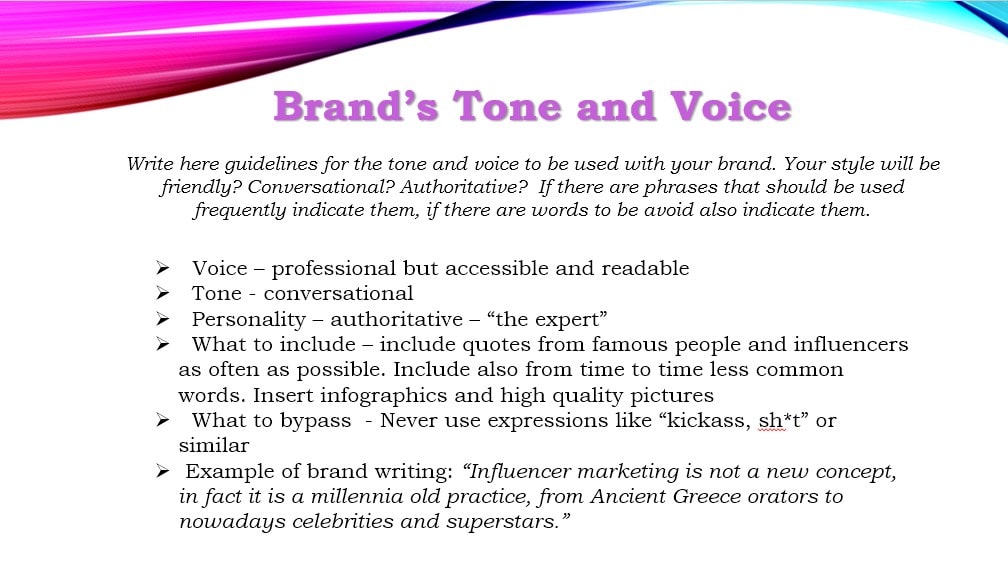
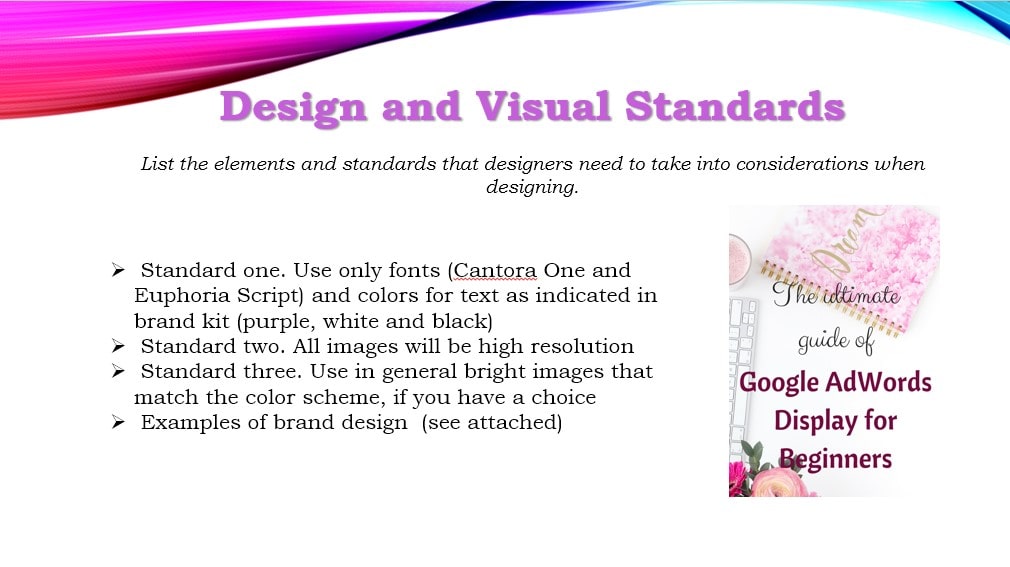
Key Pillars of Content
The pillars of content indicated above are to be organized and scheduled based on the corresponding campaigns that are scheduled for that period.
Content creation flow example
Generally, the content creation process encompasses all stages until the content is handed over to editors and designers.
The content execution process involves the creation and editorial processes, with a clear delineation of roles and responsibilities, order of tasks, and deadlines. The people involved in this phase may include content managers, writers, editors, designers, and SEO specialists.
Example of content creation flow:
- Topic brainstorming – 2-3 days
- Setting the publication date and populating the publishing calendar – 1 day
- Researching resources on the topic – 1 day
- Conducting interviews or gathering data – 3-7 days
- Researching and determining the Latent Semantic Indexing (LSI) keywords to be used for the topic – 1 day
- Creating the content structure – outline – 2 days
- Reviewing and approving the outline – 1 day
- Producing the initial draft of the content – 2-3 days, depending on the length
- Revising, editing, and proofreading the draft – 1-4 days, depending on the type of content
Consider the duration of this process when setting the start date for writing each piece of content based on the publication date.
After the content is created, it proceeds through the editorial process.
The editorial process involves organizing the steps involved in preparing the content for publication, the publishing itself, and analyzing the results.
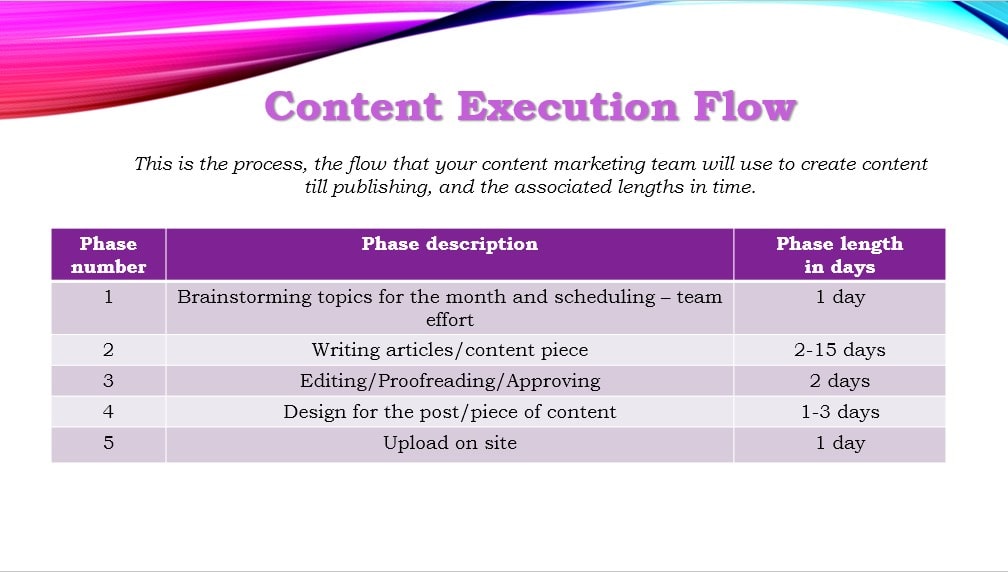
Editorial process flow example
- Content editing: 1-4 days
- Requesting revisions from writers (if necessary): 1-2 days
- Content design and graphics: 1-5 days
- Approving the design: 1 day
- SEO optimizing the content: 2-4 days
- Publishing the content: 1 day
- Setting up the promotion campaign: 2-4 days
- Approving and executing the promotion campaign according to the strategy
- Analyzing the post-publication results.
Make sure to factor in the length of this process when scheduling the writing process for each piece of content based on the publication date.
Publishing Cadence
Now that you have the content execution process established, the next obvious step is to organize the publishing cadence and schedule. Meaning what type of content gets published, when, and how often.
The publishing cadence might be something like this:
- 1 article/blog post a week – 2000 words +
- a case study monthly
- 1 infographic monthly
- an ebook each 4 months
- one lead magnet each quarter
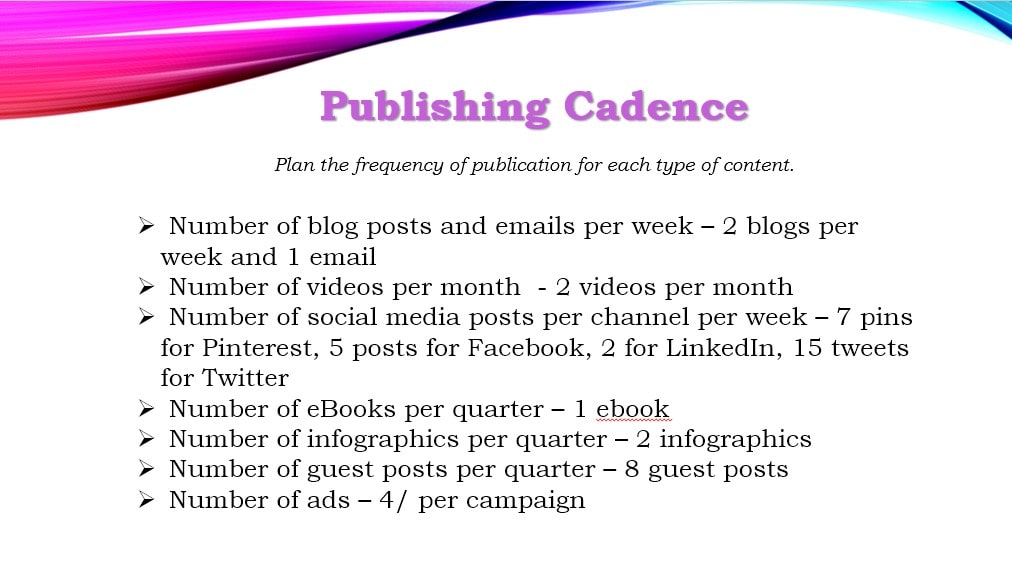
Editorial Calendar
Once your content is published, the content execution process is complete. Content calendars are crucial for organizing tasks efficiently among team members.
Your content calendar should include the following details for each content type you plan to create:
- Title of the piece of content/article
- Scheduled publication date
- Content pillar it belongs to
- Stage of the buyer journey
- Content format
- Distribution channels – where the content will be promoted.
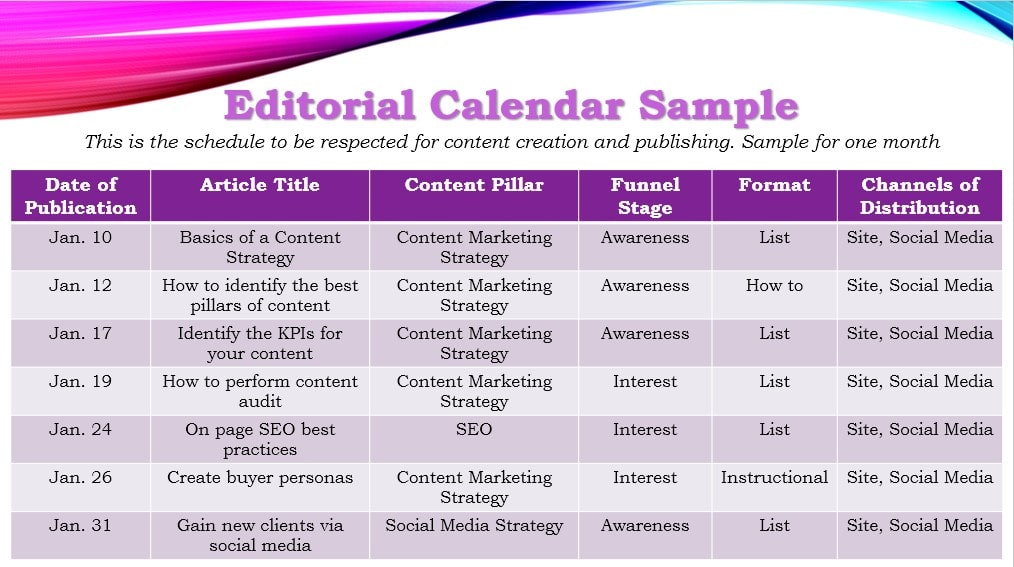
Content Strategy Example: Content Promotion Channels
Determining the appropriate channels to promote your content is a crucial task. It is essential to consider being present on the same social platforms as your target audience.
Your primary channel should be your website, which serves as your primary platform and asset.
The second important channel is your email list. It is often emphasized that the email list is the most valuable asset of a business in today’s rapidly changing digital landscape.
Social media is a collection of platforms where you should have a presence and promote your content. Select and concentrate only on social media networks where your ideal customer is active.
Choose wisely, based on analytics. I recommend focusing on no more than 2-3 channels to maintain a strong presence.
Identify additional channels to bolster your outreach strategy, such as guest posting. Develop a roster of influencers in your industry or related industries to approach about guest posting on their websites.
Once the social media channels are decided, the following step is to create a plan and schedule to promote your content.
Each piece of content will religiously respect this schedule.
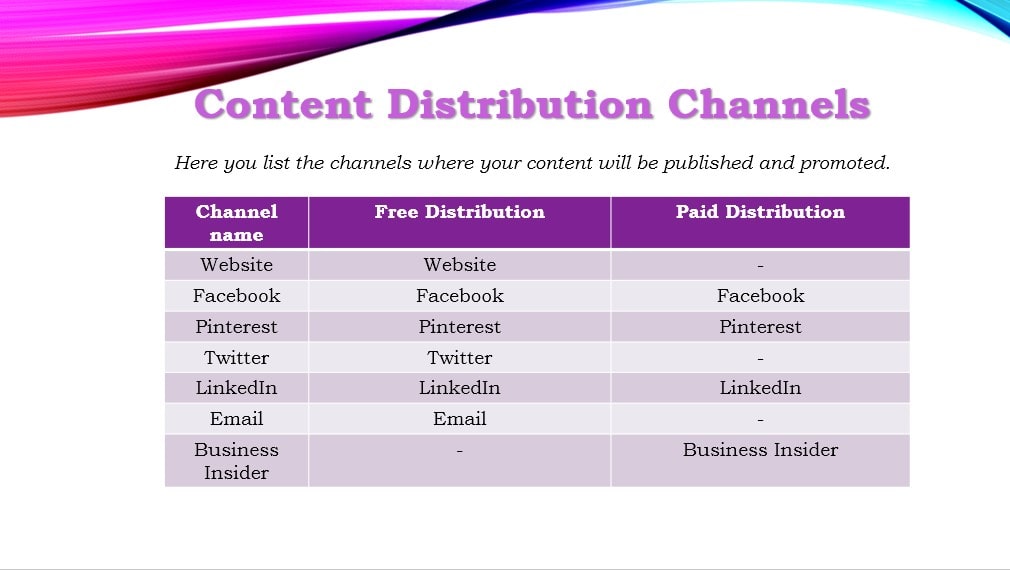
Free Distribution Plan
For the free distribution of your content, you need to complete:
- the promotional channels where your content will be published, aka Facebook, Instagram, Twitter, etc
- frequency of publishing
- the objective of the page, where appropriate
- who is the targeted buyer persona
- what do you want your reader to do – for instance, subscribe to a webinar, download a freebie, etc
- select the performance indicators that will indicate your results.
A promotion schedule on social media channels might look like this:
Day of publishing:
- One Pin on Pinterest
- One Facebook post
- 1 Instagram post
- Three Twitter posts
One week after publishing:
- 1 LinkedIn repost
- Two Twits three days a week
- One Medium repost
- One Pin daily on group boards
Following weeks till one month after publishing:
- One LinkedIn repost after one month of publishing
- Two Tweets three days of a week, four weeks after publishing
- 1 repost weekly on Facebook
- One Pin daily for one month in group boards and own relevant boards
Paid Distribution Plan
Similar to your free distribution plan you should have a paid distribution plan.
For your paid distribution you might take into consideration:
- Native advertising
- Influencer marketing
- Paid social media promotion
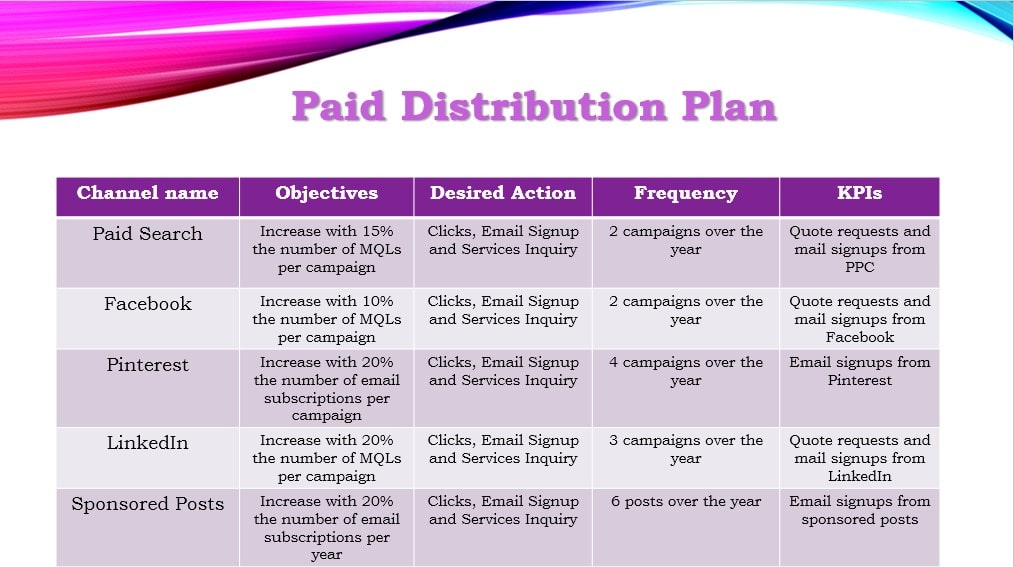
Measure KPIs and Results
Measuring the success and effectiveness of marketing content is a significant challenge for marketers.
It is important to not only identify the appropriate metrics but also interpret them correctly. For instance, the impact of the bounce rate on the success of your content and whether page views are a significant indicator of success are subject to debate.
Below are some metrics that marketers should consider when measuring the success of their content:
- Pageviews: A high number of page views suggests that the right audience has been attracted to the content and products.
- Time on page: The longer a visitor spends on a page, the more useful they found the content.
- Social shares: The more a piece of content is shared on social media, the more successful it is perceived to be.
- Bounce rate: A low bounce rate indicates that the audience is interested in the content, whereas a high bounce rate suggests that the audience was not engaged.
Once the appropriate metrics have been selected, marketers need to determine how frequently they will generate reports and create templates for these reports.
Key Performance Indicators (KPIs)
To measure your progress and success you need to establish some indicators to guide you on whether you are on the right path or not. These are specific metrics relevant to your goals.
KPIs are different for each business, depending on the services or products they provide and on their targeted goals.
The most common KPIs are:
- Number of new customers or users for the planned period
- Total revenue
- Unique or total views/impressions
- Number of subscribers to the newsletter
- Number of content shares
Remember your KPIs should match your goals.
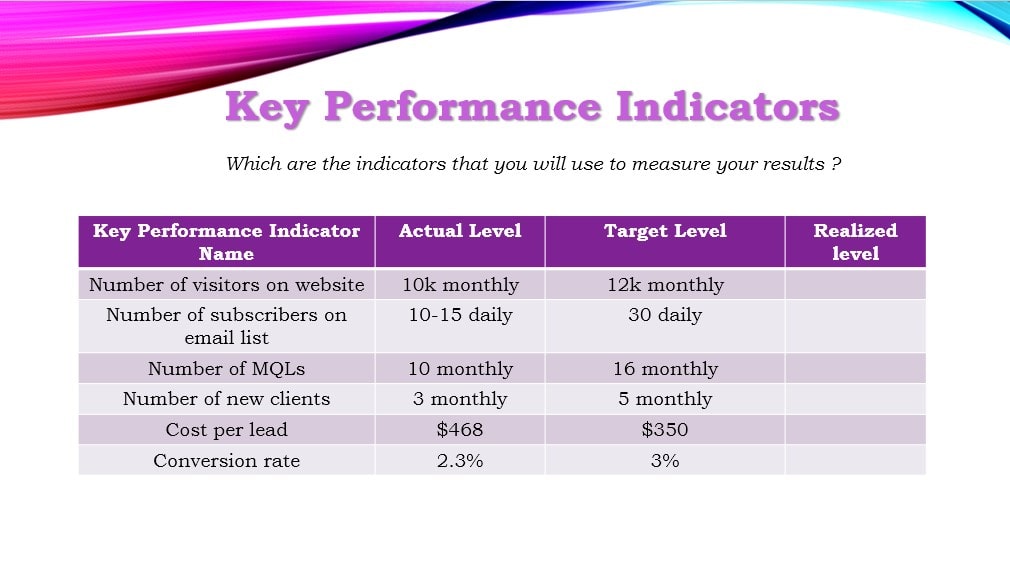
Metrics and Content Analytics
After deciding on KPIs, it’s time to establish the metrics that are relevant for you and that you need to constantly review. To avoid any confusion, keep in mind that all KPIs are metrics, but not all metrics are considered KPIs. Meaning a metric that is considered KPI for one business for one might be irrelevant.
At this point, you should simply translate the goals you set, into measurable metrics related to your KPIs:
- Reach X views per month on the blog.
- Generate $X in revenue.
- Gain X new followers on X social media channels.
- Add X new subscribers to the email list each month.
- Reach X number of shares per post per month.
Always keep an eye on the performance of your content.
Check regularly Google Analytics or Analytics sections of social media channels to observe the evolution of your content results. Optimize and adjust accordingly.
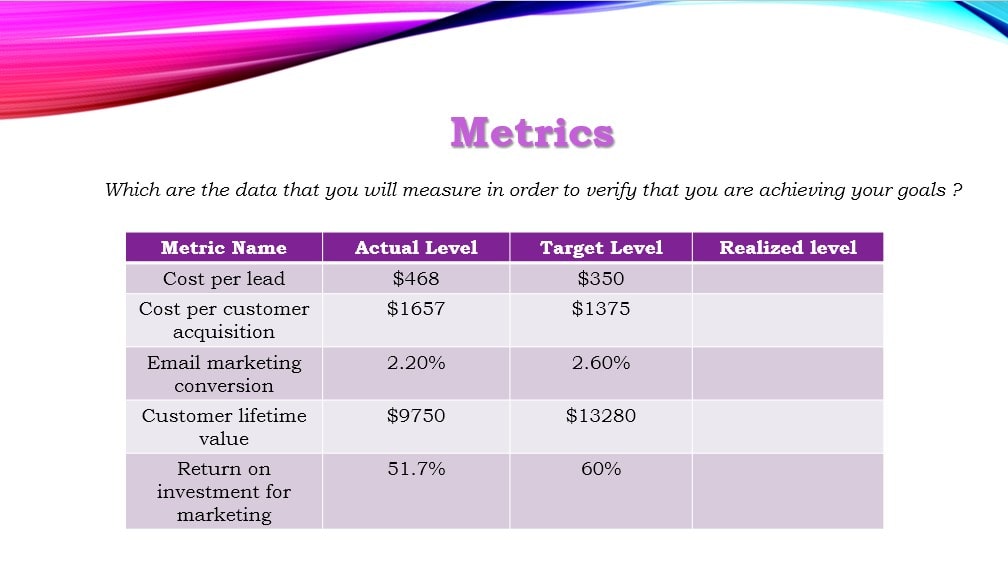
Content Strategy Example: Content Marketing Budget
You are just about to complete your content marketing strategy. The final step is the budget!
To correctly forecast the costs of producing and distributing your content (except the tools that you pay monthly or yearly) check the offers you have from the contractors you work with or the hourly rate for your in-house employees.
For content writing, take the editorial calendar and see how many words you need to create monthly, and then multiply the result by the cost per word.
Let’s say you need the first month of 12,500 words written for all the content types, you have an average cost of $0.3 per word, which would be $3,750 total cost with content writing for the respective month. Add the cost for each month and you obtain the total cost for the year.
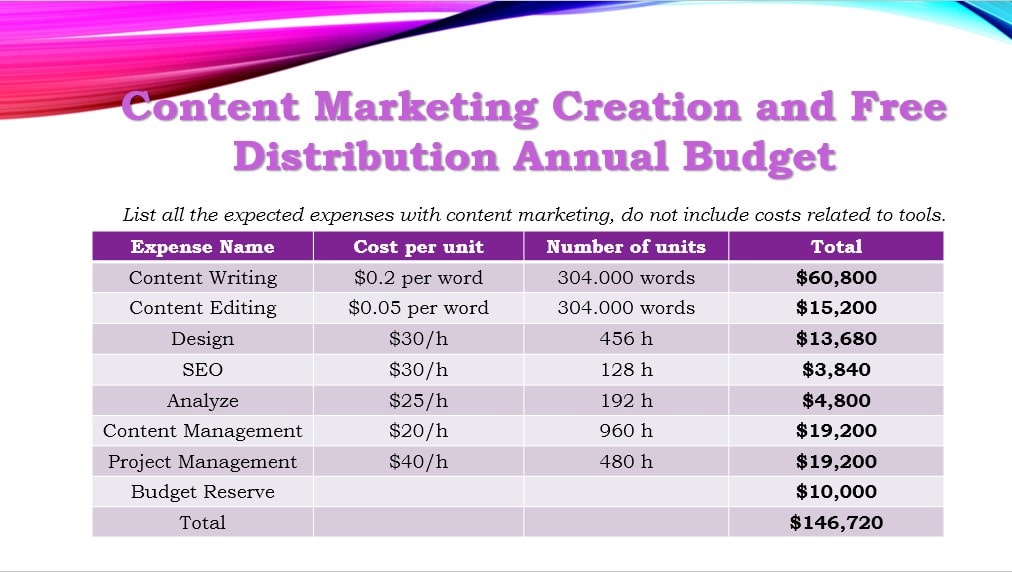
Finally, after following the content strategy example you have your content strategy created and documented. If you feel you still need help with your content strategy framework, consider hiring an expert.
FAQs
To document a content strategy you have to write down and follow all the following steps of a content strategy:
* Define your mission,
* Establish your team,
* Decide your marketing toolbox,
* Audit your content,
* Set your content marketing goals,
* Define your buyer persona
* Determine your pillars of content and topics
* Create an editorial calendar and flow
* Decide on content distribution channels and craft a distribution plan
* Establish KPIs and measure the results
* Set a content strategy budget
The content strategy process is the concert activity of documenting a content strategy with all its components: strategy goals, content audit, buyer personas, pillars of content, editorial calendar and flow, content distribution plan, KPIs and results measurement, budget, content marketing team, and toolbox.
A website content strategy is the part of the content strategy that refers strictly to the website of a company. Taking into consideration that all the content created via a strategy will be first published on the website, this is its core part. It refers in principal to the pillars of content and topics published. And may include blogs, articles, how-tos, infographics, case studies, videos, and white papers, among others.
